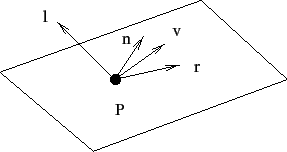More Light on Light
Tom Kelliher, CS 320
Apr. 13, 2011
Read Chapter 6 (with heart!).
Introduction to light.
- Review of
twoWindowsOne.c and twoWindowsTwo.c.
- Derivation of Phong lighting model.
- Computing normal vectors.
Lighting lab.
- Consider an object point,
 and a light source
and a light source  .
.
- Important vectors:
 : vector to light source.
: vector to light source.
 : surface normal.
: surface normal.
 : vector to COP.
: vector to COP.
 : reflection vector.
: reflection vector.
- The light from source to object can be described by:
(theoretically wrong but, in practice, right)
- Using material properties, distance from source, orientation of
surface and direction of source a reflection matrix can be constructed:
- (Simplified) Illumination at
 :
:
A global ambient term may be ``thrown'' in.
Same at each point on a surface:
Repeat for each color.
- Diffuse surface brightest at noon, dimmest at dawn, dusk.
- Lambert's law: we see only the vertical component of light:
- If
 and
and  are normalized:
are normalized:
So:
- Specular reflection produces highlights.
- The smoother the surface (higher shininess) the narrower the range
of reflection angles.
- Reflectivity proportional to angle between viewer (
 ) and
perfect reflection (
) and
perfect reflection ( ):
):
where  is the shininess term:
is the shininess term:
 for objects with broad highlights.
for objects with broad highlights.
- 100 to 500 for most metallic objects.
- Assuming normalized vectors:
Computed for each light source and each color:
- Outward facing normal must be specified for each vertex.
- Analytic surfaces: cross product of partial differentials
- Polygonal surfaces:
- Points of continuity.
- Points of discontinuity.
Thomas P. Kelliher
2011-04-12
Tom Kelliher

 : vector to light source.
: vector to light source.
 : surface normal.
: surface normal.
 : vector to COP.
: vector to COP.
 : reflection vector.
: reflection vector.
![\begin{displaymath}
{\bf L}_i = \left[ \begin{array}{rrr}
L_{ira} & L_{iga} & L...
... L_{ibd} \\
L_{irs} & L_{igs} & L_{ibs}
\end{array} \right]
\end{displaymath}](apr13img8.png)
![\begin{displaymath}
{\bf R}_i = \left[ \begin{array}{rrr}
R_{ira} & R_{iga} & R...
... R_{ibd} \\
R_{irs} & R_{igs} & R_{ibs}
\end{array} \right]
\end{displaymath}](apr13img9.png)

![\begin{displaymath}
{\bf L}_i = \left[ \begin{array}{rrr}
L_{ira} & L_{iga} & L...
... L_{ibd} \\
L_{irs} & L_{igs} & L_{ibs}
\end{array} \right]
\end{displaymath}](apr13img8.png)
![\begin{displaymath}
{\bf R}_i = \left[ \begin{array}{rrr}
R_{ira} & R_{iga} & R...
... R_{ibd} \\
R_{irs} & R_{igs} & R_{ibs}
\end{array} \right]
\end{displaymath}](apr13img9.png)